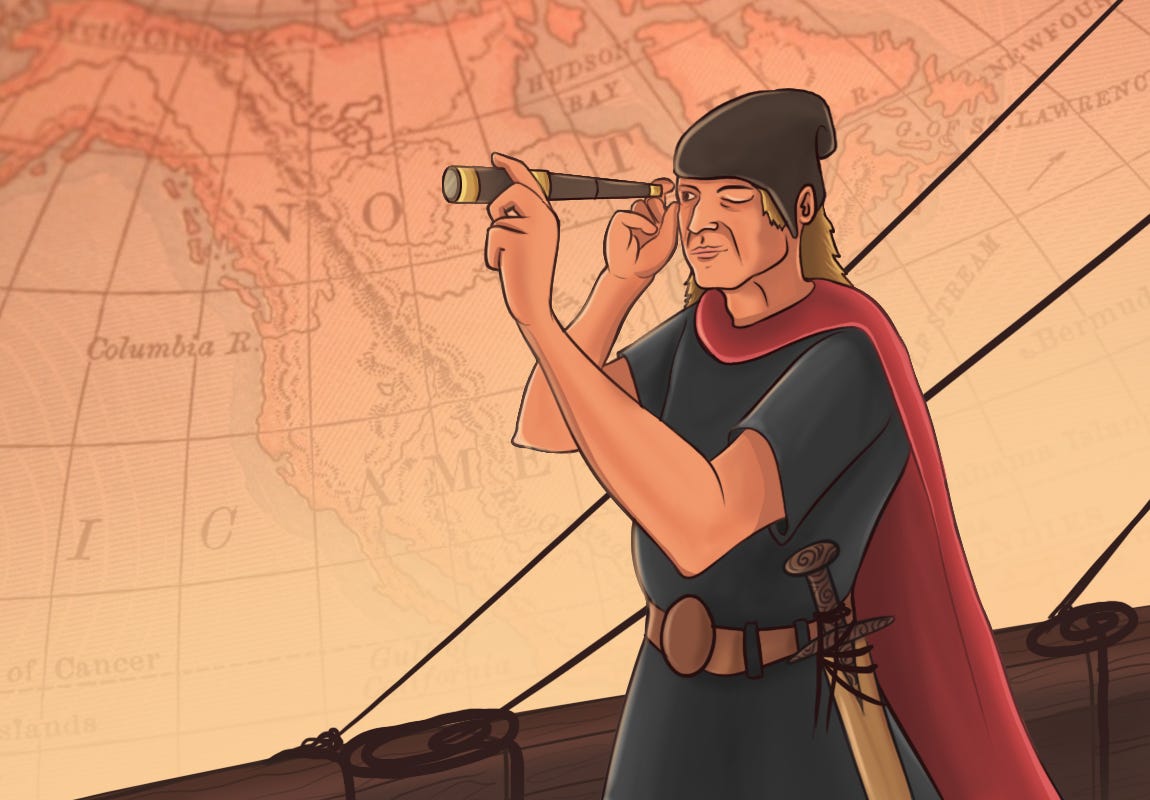Who discovered America? If the answer that comes to your mind is Christopher Columbus, then you are wrong. Columbus was not even the first European to set foot on the American continent. Columbus’s ‘discovery of America’ is one of the biggest historical lies that textbooks have taught us.
Historians believe that people migrated from the Asian continent to the North American continent about 15,000 to 20,000 years ago. Despite the controversy, it is generally accepted that the migration took place during the last years of the final Ice Age on Earth. During that time, there existed a territory that connected Asia and North America. Studies reveal that this area, known as the Bering Strait, disappeared when sea levels rose.
But in terms of modern human history, according to Birgitta Wallace, author of Westward Vikings: The Saga of L’Anse aux Meadows, a Viking sailor named Leif Erikson had set foot in America almost 500 years before Christopher Columbus was born.
The Vikings (Norse), who were influential all over Europe from the 9th to the 11th century hailed from Denmark, Norway, and Sweden – now known as the Scandinavian countries. Though their main occupation was agriculture, the Vikings were renowned sailors. They sailed on specially designed ships known as longships in search of new shores.
According to Birgitta Wallace, there is an argument that Erikson, who had converted to Christianity in Norway, went to the American continent by mistake, on his way to propagate his religion.
Leif Erikson, the son of the famous Viking sailor Erik the Red, was born in Iceland between 970 AD and 980 AD. Erik was exiled from the country for killing three people during a brawl. Being a sailor, Erik set out in search of a new place to live, and eventually managed to find one. He named the land he discovered Greenland. Naming a mostly snow-covered place (over 80%) Greenland was a testament to Erik’s craftiness – the name Greenland was suggestive of a ‘land filled with greenery.’ This was done intentionally to attract millions of other Vikings to the place.
Born in Iceland and raised in Greenland, Leif Erikson became the leader of the Vikings after his father’s death. Following his father’s footsteps, Erikson took to sea voyages and sailed westward in his twenties which brought him to the American mainland.
According to Birgitta Wallace, there is an argument that Erikson, who had converted to Christianity in Norway, went to the American continent by mistake, on his way to propagate his religion. It is believed that Erikson reached the North American coast in the year 1000 AD. He called the region Vineland or Vinland, which means ‘land of grapevine’. Leif Erikson’s American exploration became the theme of many Viking mythological narratives.
Historians used to regard these accounts as mere fiction. However, in 1960, Norwegian explorer Helge Ingstad and his wife, the archaeologist Ann Stine Ingstad, discovered remains of the Norse settlement at L’Anse aux Meadows. They estimated that the articles excavated from this area on the northern tip of the Canadian province of Newfoundland, were about 1,000 years old. This was the period when Leif Erikson was believed to have arrived in America. With this discovery, Erikson’s Viking tales, which many thought of as mere stories at the time, came to be supported as truism with the uncovering of the archaeological evidence.
The argument that Scandinavian Vikings were the first Europeans to set foot in America was brought to the mainstream by a book that came out in 1874, titled America Not Discovered by Columbus, written by Norwegian-American writer Rasmus B Anderson. Based on a study conducted by two Norwegian-American researchers in 1925, Calvin Coolidge, the President of the United States, gave proper recognition to the accomplishment of Leif Erikson. This became the subject of much debate as allegations arose from various quarters, claiming that the ulterior motive behind Coolidge’s actions was to secure votes from voters of Scandinavian descent.
In 1964, October 9 was officially declared as Leif Erikson Day. Today, Erikson Day is a public holiday in the United States. His statues and monuments can be seen at many places in the country.
It was on October 12, 1492, that the ship on which Christopher Columbus travelled, touched the shores of the ‘new’ continent (though people had been living there for thousands of years before Columbus arrived). Columbus began his voyage from Spain on August 3, 1492, to find a new and better sea route to reach India and China, for trade. King Ferdinand II of Spain and Queen Isabella had high hopes for the Italian sailor’s expedition. They also believed that immense wealth would reach the country through the new trade route that was going to be discovered.
The direction Columbus chose for the journey was also strange. Instead of heading east, Columbus’ fleet headed west. It should be remembered that it was a time when the majority believed that the Earth was flat. Naturally, the natives would have described Columbus as a madman.
News of the Italian sailor discovering new land spread like wildfire throughout Europe. Columbus was opening up a continent to the European empires that were seeking more territory for occupation.
Columbus returned to the king with the information that the Native Americans could be easily subdued and exploited. The Spanish king was convinced when he saw the captives, gold, spices, and other resources Columbus had brought back with him. During the period up to 1506, Columbus made three more American explorations.
In 1937, President Franklin D Roosevelt proclaimed the second Monday of October as Columbus Day, a public holiday to commemorate to the landing of Christopher Columbus in the New World.
For the rest of the world, Christopher Columbus opened up a vast expanse of opportunity. However, the indigenous people who inhabited America at that time were subjected to slavery and flagrant exploitation.
When the Columbus-led expedition landed in the Bahamas in 1492, it was home to millions of people from over 600 tribes. It is estimated that about 90 per cent of the Native American population was wiped out by the onslaught of the European occupation forces. The history of brutal killings, dismemberment, and sexually imprisonment of little girls as punishment, for not delivering enough gold, and opposing the colonisers, is a cruel backdrop to Columbus’s ‘heroic’ American expedition.
In 1937, President Franklin D Roosevelt proclaimed the second Monday of October as Columbus Day, a public holiday to commemorate to the landing of Christopher Columbus in the New World. However, there were a lot of disagreements over celebrating Columbus Day. Protests erupted from many quarters against honouring a man who had murdered and enslaved the Native American people as a hero. Today, in many parts of the United States, it is celebrated as Native American Day, Indigenous People’s Day, and so on.
There is another argument that the Chinese were the first foreigners to set foot in America. This argument was also made in the books titled 1421: The Year China Discovered America (published in 2002, written by Gavin Menzies) and Who Discovered America: The Untold History of the People of the Americas (published in 2013, co-authored by Ian Hudson and Menzies). In his book, Menzies tries to prove that America was discovered by the Chinese sailor Zheng, but historians consider such arguments as falsification of history.
In addition to all these, there are many other arguments regarding the discovery of America. History researchers are still trying to determine which of these is true.
While the debate over who should be bestowed the honour of being the first to set foot in America continues, one thing can be said with certainty –the American continent was originally discovered and made habitable by the ancestors of the Native tribes who were exploited by foreigners.
Now put on your thinking hats and think about the following questions for a couple of minutes.
How significant is for us to remember that Columbus was not the first person to set foot on the American continent?
Can you think of the importance of the book titled America Not Discovered by Columbus in bringing the fact that Vikings were the first to foot in America to the mainstream?
Write down your thoughts and discuss them with your students, children and your colleagues. Listen to their views and compare them with your own. As you listen to others, note how similar or different your views are to others’.
Thank you for listening. Subscribe to The Scando Review on thescandoreview.com.
Happy Teaching!













Who discovered America? (Not Christopher Columbus)